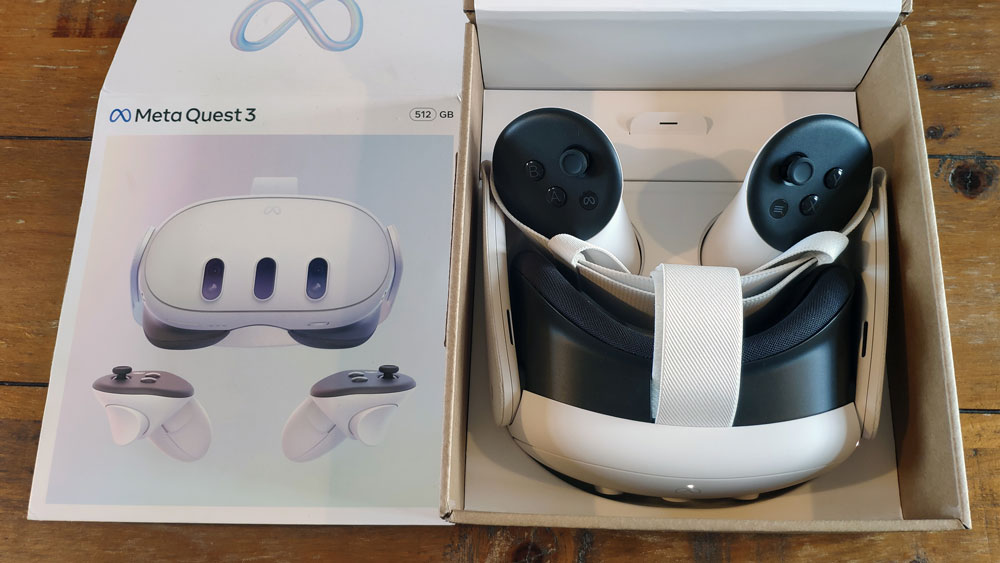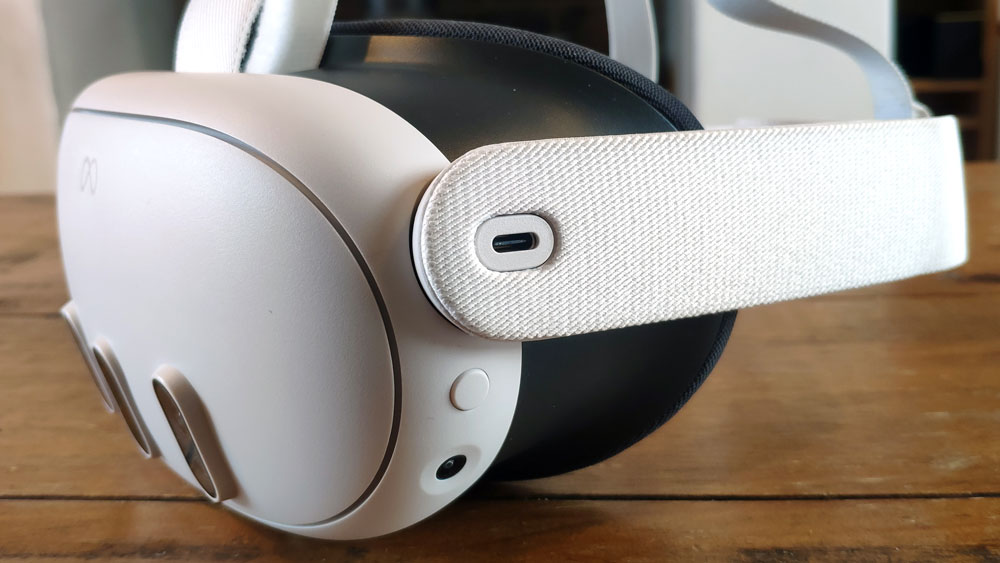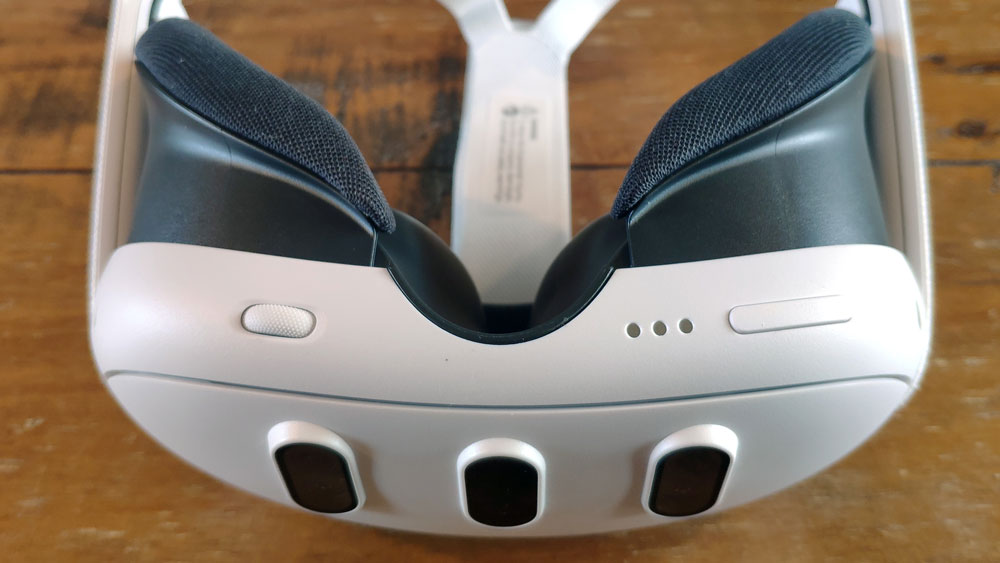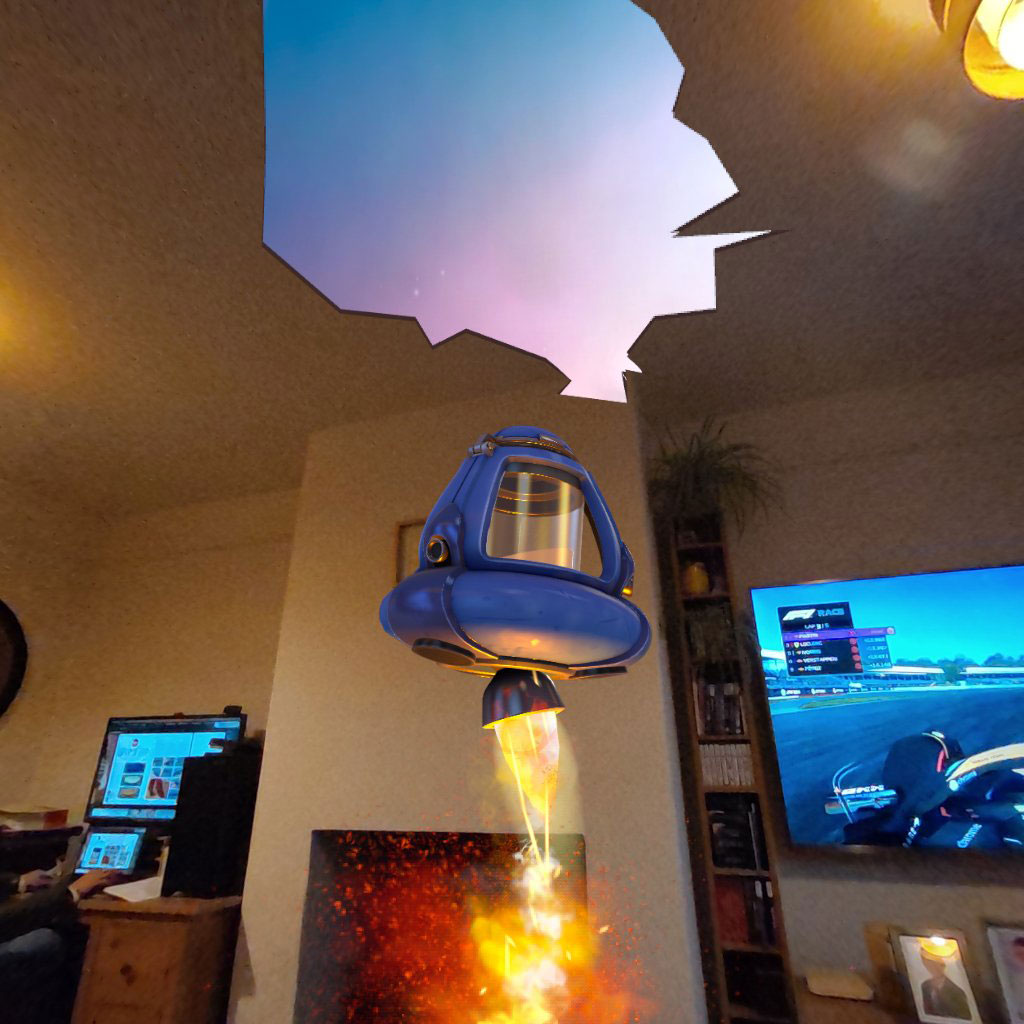
The Meta Quest 3 is the latest VR headset intended to lure us into the metaverse. However, since the launch of the Quest 2 in 2020, we’ve also seen the release of the Meta’s high-end headset, the Meta Quest Pro, which featured full-colour passthrough for mixed reality, a thinner form factor, pancake lenses, integrated facial tracking, and more. So the question is how many of these ‘Pro’ features have made it into the Quest 3? And has Meta addressed the issues that many people had with the Quest 2?
One of the biggest problems with the Quest 2 was the original requirement of a Facebook account to use it. We don’t need to go into the various arguments for and against using Facebook here, but it became an issue that overshadowed many of the product’s benefits. Thankfully, at the end of 2022 Meta changed this policy, and you can now use Meta headsets with a separate Meta account. Another issue with the Quest 2 was the lack of colour passthrough, which allows you to see a real-time view of your surroundings, and have VR elements interacting alongside physical objects. But this has also been addressed within the Quest 3.
As well as introducing a number of ‘Pro’ features, Meta claims that the Quest 3 is also its most powerful headset to date, and our experience with the device suggests that all the hype may have been worth it, and it is sure to be added into our best VR headsets guide.
In the box: Meta Quest 3

When unboxing the Meta Quest 3 the first thing you’ll notice is that, in comparison to its predecessor, it’s far more compact. In fact, according to Meta, the Quest 3 is now 40% slimmer than the previous iteration, which when coupled with the three front-facing cameras makes it easy to distinguish from its older sibling.
Alongside the headset you also get two controllers, each of which has a thumbstick, two triggers, two control buttons, and a menu button. These are essentially the same controls found with the Meta Quest 2, but—unlike those controllers—these no longer have the cumbersome plastic “halo” found on most VR handsets, which is a real bonus.
As with most technology products nowadays, you won’t find a thick set of instructions accompanying the Meta Quest 3; you simply follow a few basic steps, install the accompanying mobile app (via a URL or QR code) and you’re ready to get started. And if you order a Meta Quest 3 before January 27th you will also get a free copy of Asgard’s Wrath 2 (which is PEGI rated 18, and retails for £44.99).
Setting up: Meta Quest 3

Before you start using your headset, you should ensure that it fits comfortably. This is easy to do, via adjustable back and top straps, which can be loosened and tightened via velcro and sliding attachments. If you wear glasses, there are two depth adjuster buttons inside the headset, which, when pressed, enable you to create more distance between your face and the lenses. This should give most people enough room to play with; but if you find that you still don’t have enough space, you can purchase replacement prescription lenses from Zenni VR.
Once you have the headset positioned comfortably, you start up the device by pressing the power button (situated on the left side of the headset). And once the device has powered up, you will be taken through a quick tutorial, which includes moving the lens adjustment wheel on the bottom left-hand side of the headset, giving you the option to change how close together the lenses are.
One of the benefits of the Meta Quest 3 is how easy and intuitive the setup process is. And once you’ve got your headset configured, you can dive straight into the tutorial app, which walks you through using the controllers, moving around the metaverse, and taking images and video whilst using the headset.
Design: Meta Quest 3

The general design of the Meta Quest 3 is a marked improvement on its predecessor. The ergonomics of any VR headset are one of the primary factors to consider when evaluating them, as they can have a huge impact on the overall experience.
In the case of the Quest 3, weight is still unevenly distributed, with the main body of the device sitting on your face (whereas the Quest Pro has a battery that sits at the back of your head, delivering a more even weight distribution). Having said this, a slimmer form factor puts the weight nearer your face, and it is noticeably more comfortable than the Quest 2. Is it perfect? Absolutely not. It still weighs 515g, and that much weight sitting on your face will eventually become uncomfortable after an hour or two. But with the addition of the Meta Quest 3 Elite strap with battery, you can get an even better balance, almost identical to the experience with the Quest Pro.
When it comes to button positions on the headset, they are all well considered, as are the 3.5mm headphone jack and the USB-C charge port. And the overall build quality is high, as you’d expect for a product in this price range.
Controllers: Meta Quest 3

The major difference between the controllers for the Meta Quest 2 and 3 is the removal of the annoying rings, or “halos”, that many older VR controllers require for tracking. In previous Quest handsets these rings contained important sensors, but the Quest 3 uses AI technology and IR LEDs, which are embedded in the top of the controller instead. This makes the ergonomics of the controller far better, freeing up your thumbs, and reducing the chance of sustaining damage to the sensors.
Another key feature from the Quest Pro that’s been transferred to the Meta Quest 3 is the addition of TruTouch haptics, which provides a greater degree of interaction. Sadly, though, the tracking camera from the Quest Pro controllers has not been included. And it’s also a little disappointing to see the controllers still requiring AA batteries, but it’s a minor gripe. And the controllers are a pleasure to use.
Specs and features: Meta Quest 3

The Meta Quest 3 comes with full-colour passthrough for augmented reality (AR), which is delivered via dual 18 PPD (peak pixel density) cameras. This is by far the biggest single upgrade in the Quest 3, and is also an improvement over what the Quest Pro’s single RGB camera delivered. But whilst the passthrough image quality is good enough to distinguish text in books and on your phone, reading for any length of time is uncomfortable.
Display: Two LCD displays. 2064 x 2208 pixels per eye
Chipset: Qualcomm Snapdragon XR2 Gen 2
CPU: Octa-core Kryo (1 x 3.19 GHz, 4 x 2.8 GHz, 3 x 2.0 GHz)
GPU: Adreno 740
Memory: 8GB
Storage: 128GB (512GB also available)
Lenses: Pancake lenses
Refresh rate: 72Hz, 80Hz, 90Hz, 120Hz
Field of view: 110 degrees horizontal, 96 degrees vertical
Passthrough: Dual 18 PPD color passthrough cameras (also used for tracking)
Tracking: Supports 6DoF (six degrees of freedom). Uses 4 cameras for visual controller tracking, two front-facing color cameras for stereoscopic 3D mixed reality. Includes front-facing depth sensor, and gyroscopes and accelerometers in headset/controllers
Feedback: Haptics on controllers but not headset
Battery life: 2-3 hours
Charge time: 2.5 hours
Audio: Integrated 3D stereo speakers, 3.5mm audio jack, in-built mic
Connectivity: USB-C, Wi-Fi 6E, Bluetooth 5.2 (with latency)
Weight: 515g
The Quest 3 comes with a free game called First Encounters, which does a wonderful job of showcasing the AR capabilities of the device. The premise is a simple one: you basically have to shoot a load of aliens that are bursting into your home (or whichever space you’re using the headset in). It’s a lot of fun. And a perfect AR showcase. But what it also highlights is how the Quest 3 is now able to effectively map your surroundings, without the need for external sensors, so you can have VR and physical elements interacting within the same space. Meta plans to do a lot more with this technology and, if First Encounters is anything to go by, we’re really excited to see what developers can achieve.
General improvements have been made in other areas of the device, too, with LCD displays now supporting 2064 x 2208 pixels per eye (a 30% improvement), and Meta upgrading its Fresnel lenses to Pancake lenses, which have fewer chromatic aberrations, and cut the distance needed between your eyes and the display (enabling a slimmer form factor).
Audio and performance: Meta Quest 3

Thanks to an upgrade to the new Snapdragon XR2 Gen 2 chipset, the Meta Quest 3 comes with a big performance boost over previous Meta headsets, and this – along with the extra power requirements of colour passthrough – is why we haven’t seen big gains in battery life. But at around two hours, it should be enough for most VR experiences. And for those needing extra power, there are external battery packs (mentioned above) that can extend the battery life of the Meta Quest 3 by another two hours.
The Meta Quest 3 speakers are embedded in the arms that sit on either side of your head, and they do a brilliant job, especially using the headset’s 3D audio (which helps identify the direction of sounds, especially when gaming). According to Meta, these speakers are 40% louder than the Quest 2, but it’s very unlikely that you’ll need to go anywhere near the maximum volume (and if you do, the sound leakage is likely to annoy those around you). If you are concerned about sound leakage, there is a 3.5mm audio jack, so you can plug headphones directly into the device. And the Meta Quest 3 also has two embedded mics situated at the bottom of the headset.
Should you buy the Meta Quest 3?

In a world where technology features are often drip fed into product upgrades, it’s reassuring to see Meta making so many big improvements to the Quest 3. And whilst not every feature from the Quest Pro has been included in this latest launch – facial tracking being one of the main omissions – Meta has integrated some of the Pro’s best attributes.
There are still major challenges for VR, though. It’s a hard technology to sell without actually exposing someone to a headset. And with over 1,000 apps at your fingertips—whether used for gaming, collaborating with colleagues, experiencing live events, or a host of other use cases—selling the benefits of VR can be difficult. But with Meta having reportedly sold 20 million headsets, more people than ever are getting their first taste of VR.
With the number of improvements made to the Meta Quest 3, it is now the best standalone VR headsets currently available. And in almost every respect—whether it’s design, comfort, performance, or usability – the Meta Quest 3 excels.
Read more: How to use VR models in Procreate







